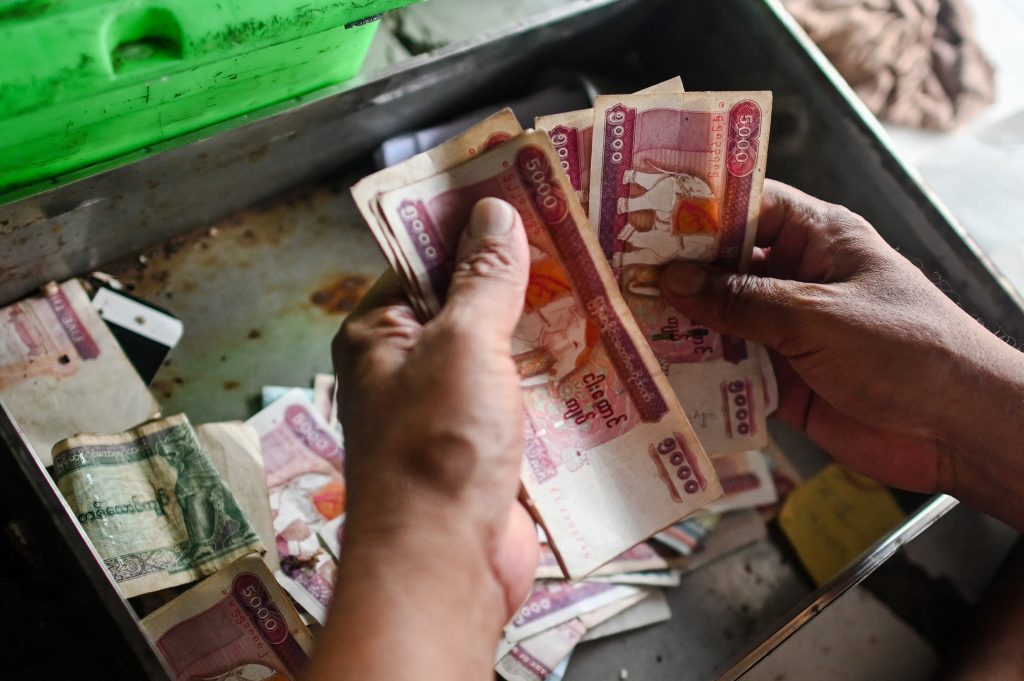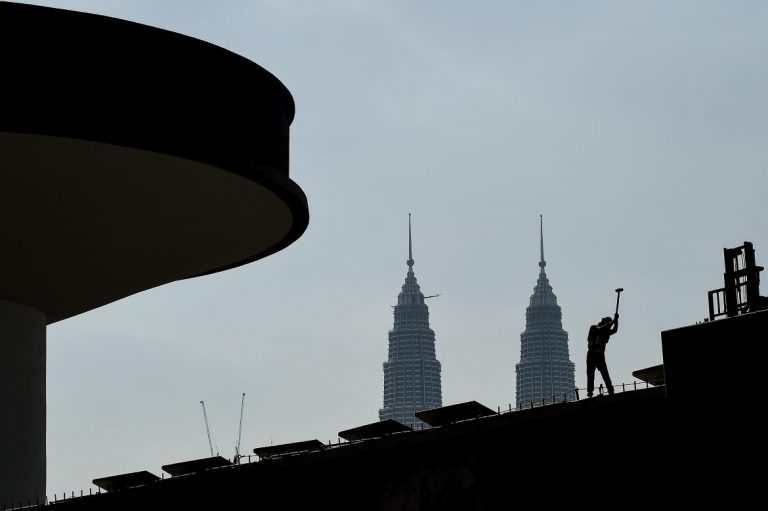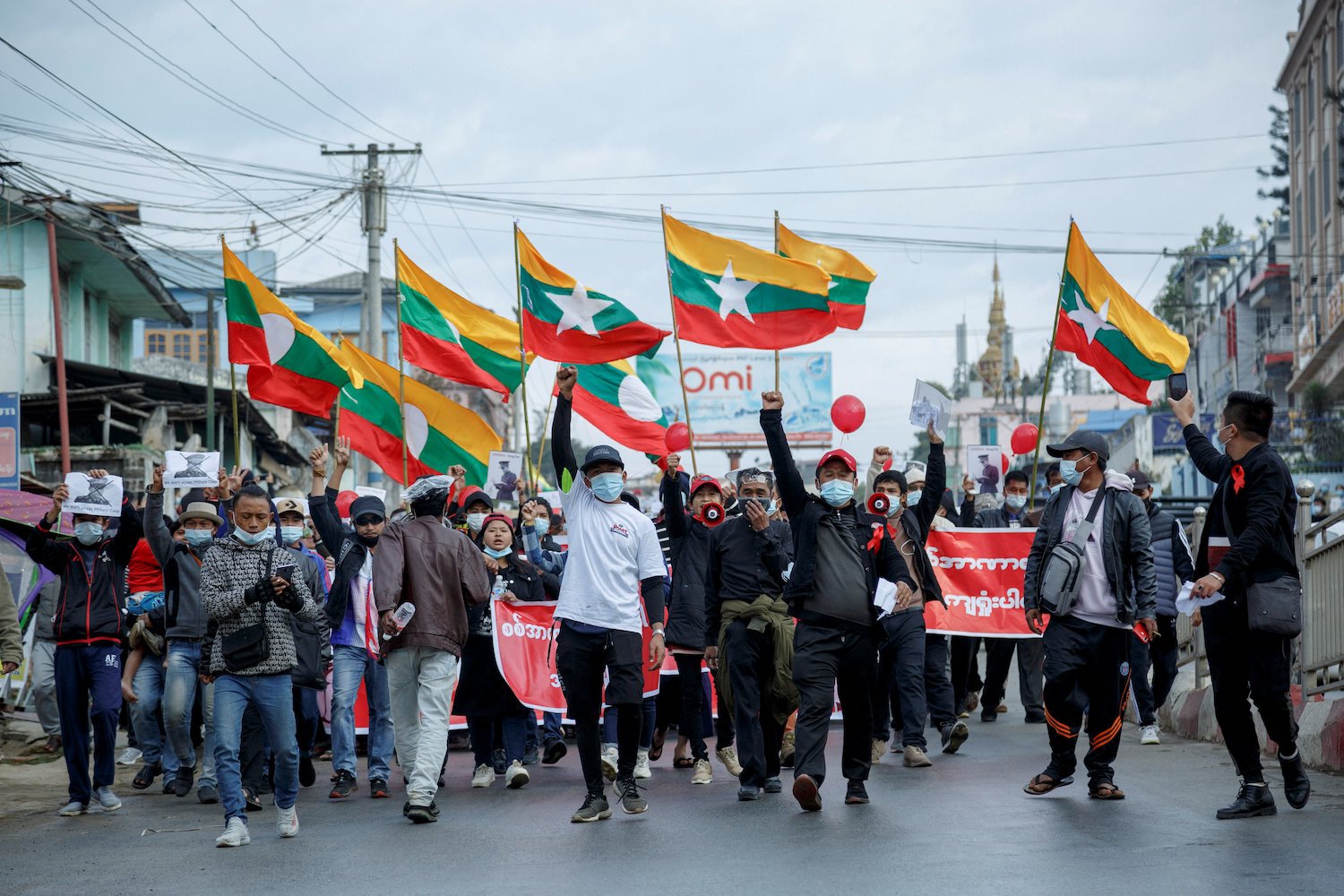The most likely outcome of the economic turmoil triggered by the coup is a period of slow economic growth and joblessness, even as inflation rises and the value of the kyat continues to slide against the US dollar.
By KHINE WIN | FRONTIER
In the months immediately following the coup, some analysts argued that the military regime had enough resources to withstand the economic pressure and disruption created by striking civil servants and private bank workers, and would be able to keep the Myanmar economy steady.
Eight months after the coup, however, the economy is anything but stable.
When the Asian Development Bank updated its forecast for the region in September, it estimated Myanmar’s GDP would shrink by 18.4 percent in 2020-21. A report by the United Nations Development Programme said nearly half of the population will be living in poverty by early 2022.
The International Food Policy Research Institute’s working paper on inorganic fertiliser use in Myanmar predicted that fertiliser sales would decline by nearly half this monsoon season, and as a result agricultural yields are likely to decrease significantly.
The kyat, meanwhile, has lost more than 60 percent of its value against the US dollar since the coup. A rapid fall in late September saw it bottom out at K2,700 to the dollar before recovering to about K2,200.
Due to the coup and the SAC’s mishandling of the economy, the people of Myanmar are now looking down the barrel of a rapidly contracting economy in which their money will be worth less, jobs are harder to come by and there may be significantly less food to go around.
Squeezed consumers and ad hoc responses
Consumers are feeling the squeeze as prices rise, including for fuel, which has more than doubled since the coup. Shortages have forced some petrol stations to suspend operations. The Central Bank has also started selling dollars at discounted rates to selected fuel importers to enable them to bring in petrol and diesel to sell below market prices. This has left other fuel importers disadvantaged and unable to import fuel.
All this leaves people to wonder what will happen if the SAC cannot control the rapid depreciation of the kyat and subsequent price volatility of essential commodities. It bears remembering that the 2007 Saffron Revolution was triggered in part by the military government’s removal of fuel subsidies, which led to dramatic increases in the cost of essentials like food.
The currency crisis can be attributed mainly to the loss of public trust in the Central Bank and the SAC. In their search for safe alternatives to the kyat in their bank accounts, people have been hoarding gold and US dollars since the coup, causing demand, and prices, for both to skyrocket and the kyat to depreciate.
Trust can make or break a banking system.
Although the quality of bank assets deteriorated rapidly after COVID-19 emerged officially in Myanmar in March 2020, and especially after the second wave between August 2020 and January 2021, there was no run on the banks because public trust in government and the central bank remained high. This was despite the banks’ vulnerability to shocks and legacy balance sheet issues, particularly the huge size of non-performing loans, or loans that were in default or were unlikely to be repaid.
For the Myanmar economy to have made a recovery in 2021, the banking sector needed political stability more than anything else.
The political stability that prevailed during the first and second COVID-19 waves evaporated on February 1. In the aftermath of the coup, internet disruptions, Central Bank limits on withdrawals, and the Civil Disobedience Movement contributed to the banking crisis, as well as the collapse of the health system and other essential public services.
The consequences of the currency crisis and emerging inflationary trend have been severe. In response to rising prices, the regime has essentially introduced subsidies and a quota system for importing refined fuel. A gradual ban on goods deemed non-essential seems likely to follow. Other essential imports, such as pharmaceuticals, have become more expensive and these items will become scarcer as time goes on.
Some have predicted that the export sector can make up for other shortfalls in the economy, but the export sector and domestic manufacturing industry are also highly dependent on the import of raw materials, the cost of which is rapidly increasing for businesses who must pay to purchase the materials in dollars.
Perhaps the most obvious example is the garment sector, which imports most of its raw materials. But as I wrote previously for Frontier on September 30, most of the fertiliser used by the country’s farmers is also imported, and rising prices have forced them to use less to grow the monsoon paddy crop. The result will be reduced yields amid rising prices, which will have an especially large impact on the agriculture sector and poor households.
Dollarisation has set in and will be difficult to reverse, even if inflation can be controlled. There is a real risk that in many transactions, dollars will be used as medium of exchange instead of the kyat or prices will be calculated in relation to the market rate of the dollar. The CBM has recognised this, and has recently attempted to control the kyat’s depreciation by issuing a directive banning exporters from keeping dollars in their accounts for more than one month. However, this is unlikely to stem the kyat’s slide..
Parallel market exchange rate and pervasive exchange controls have been the norm rather than the exception in countries with a history of high inflation, meaning that in Myanmar dollarisation will likely persist for a long time.
The most likely outcome of all of this is what economists call stagflation, which is economic stagnation combined with persistent high inflation.
The economy is in recession and prices are rising. Many people will lose their jobs, as forecast by the International Labour Organization, and the United Nations Development Programme has warned that poverty will double early next year.
The scale and scope of the economic crisis will be worse than they have predicted if banks collapse and the kyat continues to decline in value against the US dollar. The more restrictions that are imposed on bank withdrawals and the greater the depreciation of the kyat, the more people will buy US dollars and gold as safe havens. The wheel of a vicious circle is turning wildly now.
The SAC does not have the monetary and fiscal tools in its arsenal to address the country’s multiple crises and has little prospect of receiving international assistance, such as an International Monetary Fund bailout and loans. Cooperation from the public cannot be expected from the majority of the people and that will make the situation worse.
The only viable solution to the economic tragedy confronting Myanmar is a political settlement, the restoration of democracy and human rights, and the creation of a federal union.







